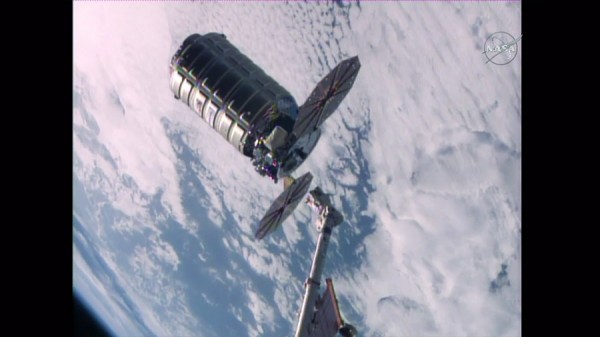By Ana Verayo, | November 22, 2016

The Orbital ATK Cygnus space freighter is seen moments after being released from the grips of the Canadarm2 robotic arm. (NASA TV)
Astronauts aboard the NASA International Space Station are preparing for their next crucial experiment which involves setting fire to a space cargo vehicle filled with trash.
Like Us on Facebook
The vehicle, which is an Orbital ATK's OA-5 Cygnus, was released by the orbiting space laboratory after docking there for almost a month. The Cygnus was detached on November 21 from the space station's robotic arm.
The Cygnus cargo vehicle was released from the Unity module port of the International Space Station. At 8:22 p.m. EST, the robotic arm released the cargo vehicle when the space station was 251 miles above the Pacific Ocean.
According to astronaut Shane Kimbrough, who commanded for the release, the ISS received more than 5,000 pounds of supplies, scientific payloads and equipment, making it an honor to work with the Cygnus space cargo vehicle.
The Cygnus was launched on October 17 perched on top of an Antares 230 rocket. After a week, it safely docked on the space station and the crew had to unload more than 5,000 pounds of cargo.
Now, the cargo vehicle is filled with trash and waste including no longer needed equipment that will re-enter the Earth's atmosphere to burn up and disintegrate completely.
However, before this imminent destruction, the Cygnus will be a crucial part of the SAFFIRE-II experiment which will continue the fire burning experiments of SAFFIRE-I, with smaller samples as opposed to one large material.
This hazardous experiment will be carried out in a safe, remote place far away from the space station and its crew. SAFFIRE is the biggest space fire experiment ever conducted in lower Earth orbit. After this, data will be transmitted back to mission ground control on Earth.
When the SAFFIRE experiment is finished this week, the Cygnus will deorbit and re-enter Earth's atmosphere and burn over the Pacific Ocean.
-
Use of Coronavirus Pandemic Drones Raises Privacy Concerns: Drones Spread Fear, Local Officials Say

-
Coronavirus Hampers The Delivery Of Lockheed Martin F-35 Stealth Fighters For 2020

-
Instagram Speeds Up Plans to Add Account Memorialization Feature Due to COVID-19 Deaths

-
NASA: Perseverance Plans to Bring 'Mars Rock' to Earth in 2031

-
600 Dead And 3,000 In The Hospital as Iranians Believed Drinking High-Concentrations of Alcohol Can Cure The Coronavirus

-
600 Dead And 3,000 In The Hospital as Iranians Believed Drinking High-Concentrations of Alcohol Can Cure The Coronavirus

-
COVID-19: Doctors, Nurses Use Virtual Reality to Learn New Skills in Treating Coronavirus Patients







